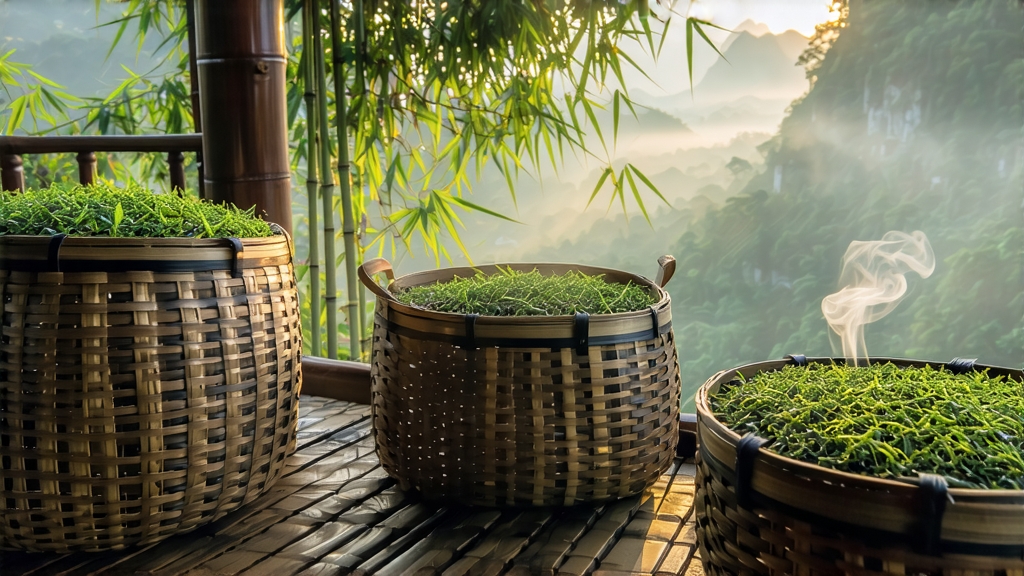
Tucked away in the humid, karst-pocked southwest of China, the small town of Liubao in Wuzhou, Guangxi, gave birth to a tea that once rode the ancient Tea-Horse Road shoulder-to-shoulder with Pu-erh, yet remains almost anonymous outside China. Liu Bao—literally “Six Forts”—is a dark, post-fermented tea whose quiet power lies in its ability to age gracefully, to soothe the stomach after a greasy meal, and to whisper stories of Qing-dynasty merchants, British clipper ships, and Malaysian tin-mine coolies. If you have only met Pu-erh, Liu Bao is its earthier, more easy-going cousin: less swagger, more depth.
History: From Imperial Tribute to Miners’ Comfort
The earliest written record appears in the 1799 edition of the Wuzhou Gazetteer, noting that “dark tea from Liubao is packed in bamboo baskets and shipped to Guangzhou, where foreign traders pay silver by the chest.” By the Jiaqing era (1796–1820), Liu Bao had become one of the first Chinese teas to be exported in bulk, travelling down the Xun River to the Pearl River Delta and on to Hong Kong, Singapore, and Kuala Lumpur. In the late nineteenth century, British plantation owners in Malaya discovered that a cup of strong Liu Bao prevented dysentery among tin-mine laborers; the tea’s reputation for “cutting the grease and cooling the heat” turned it into a commodity as vital as rice. Whole bamboo baskets—30 kg loads lined with dried banana leaf—were stacked in the holds of steamers, and the tea absorbed the saline breeze of the South China Sea, accelerating its mellowing. When the Cultural Revolution disrupted production in the 1970s, Liu Bao almost vanished; only a handful of state-run factories kept the craft alive by supplying Malaysia’s dwindling stock. Today, fueled by the same aging-craze that catapulted Pu-erh to stardom, Liu Bao is re-emerging, yet it still carries the honest scent of hard work and humid bamboo.
Leaf and Grade: The Bamboo-Basket Lexicon
Liu Bao is not a single recipe but a spectrum of leaf grades, each encoded in a quaint jargon inherited from river-port tea brokers. The top grade, “Special Flag” (特级), uses one bud with two leaves plucked before Qingming from the indigenous Da Ye cultivar that thrives in the red, iron-rich soil of Cangwu County. “First Flag” (一级) adds a sliver of third leaf, while “Second Flag” (二级) allows more stem, prized for promoting airflow during aging. Below these come “Third Flag” and “Crude Tea,” the latter a mix of leaf and stalk that compresses into the 30 kg “Big Basket” (大箩) still favored by Malaysian tea uncles who swear the stalks give sweetness. Visually, dry Liu Bao is not the jet-black of Pu-erh; it glows a dark copper, as if someone had polished a Qing-dynasty coin and scattered it with frost. The baskets themselves—woven thin strips of Phyllostachys bamboo—impart a faint grassy note that later matures into the signature “betel-nut” aroma.
Craft: Where Smoke Meets Microbes
Unlike Yunnan’s sun-dried Pu-erh, Liu Bao undergoes an extra kill-green step over pine-fire, a legacy of the region’s timber wealth. Fresh leaves are pan-fired at 280 °C for three minutes, just long enough to kill the grassy enzymes while preserving the thick-walled Da Ye cells that love to host microbes. After rolling and a brief sun-wither, the half-dried maocha is piled 70 cm deep in a humid room and left to “wet-pile” (渥堆) for 30–45 days. The pile is turned every five days, allowing a consortium of Aspergillus niger, Blastobotrys adeninivorans, and local yeasts to bloom. Temperature is judged by the bare hand of the master: too hot (> 55 °C) and the tea turns sour; too cool and the pile stalls, smelling of wet cardboard. When the core threads of leaf turn walnut-brown and a sniff reveals dried longan and damp earth, the pile is broken down, dried over gentle charcoal, and packed—still slightly tacky—into the waiting bamboo baskets. There, the tea will breathe for decades, the microbes slowly oxidizing residual polyphenols into the